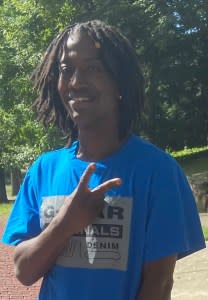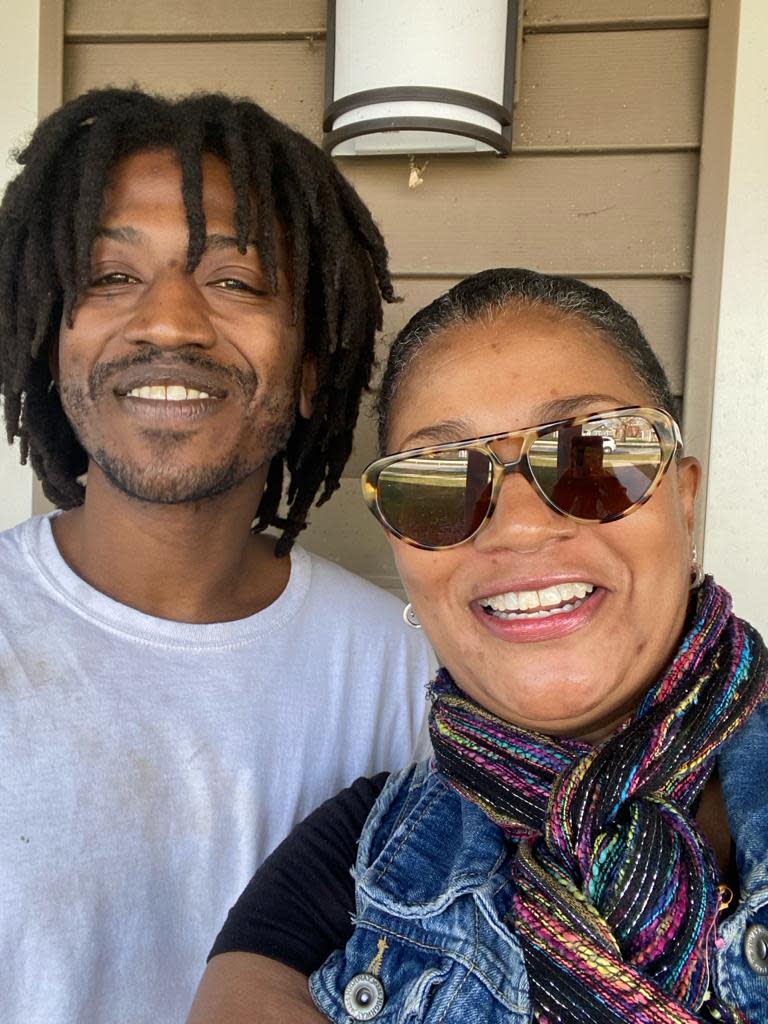No One Called 911 for an Ohio Man Having a Mental Health Crisis. An Officer Killed Him.
Kimberly Roquemore’s maternal instinct kicked into high gear during the summer of 2022. She had this unsettling feeling in the pit of her stomach that her second-oldest child, Maalik Roquemore, was in danger.
The 32-year-old was a Black man living in America with mental illness. Kimberly, a registered nurse, was a week away from moving back to Cleveland when she could tell through phone conversations that Maalik had fallen off his medication regimen. He was killed by police on Sept. 5, 2022.

Five years prior, the mother of four adult children had moved four hours away to Indiana to stay ahead of the cost of inflation — but Maalik was always in the front of her mind. He was 19 when he had his first, and last, 72-hour involuntary hold at a psychiatric hospital. Following his 2009 schizophrenia diagnosis, Roquemore says she preemptively thought about the hesitation she’d have calling 911 if Maalik were to have another episode.
“I was afraid of this very thing, that they would not use a tactical approach. They would not try to de-escalate. My son, he’s a full-grown Black man, and I didn’t want them to kill him in my face, but instead, he was killed anyway,” Roquemore told Capital B in a sorrowful tone.
Her anxiety about her son often intensified whenever she saw another headline about the number of people with mental illness, regardless of race, and Black people overall, who had been killed every year during a police encounter.
Of the 341 people killed by Ohio police, nearly 40% are Black, and more than half of the 73 people killed who had signs of mental illness were white, according to the Mapping Police Violence database that tracks fatal police encounters that occurred in the U.S. since 2013.
Three Black men — Arthur Keith, Demond Eskridge, and Maalik — were killed by a Cuyahoga Metropolitan Housing Authority police officer in three years. Prior to 2020, the CMHA police did not have any fatal incidents on record, the database showed. More than half of the 33 housing officers are white men, according to a spokesperson for the agency.
The Nov. 13, 2020, death of 19-year-old Keith was not captured on video and resulted in no indictment. Eskridge was killed three months before Maalik while also experiencing a mental health crisis, sources told 19 News. Although Eskridge’s death was captured on police body camera, a grand jury decided in December not to file charges, a spokesman for the state’s attorney general’s office confirmed to Capital B.
A Cuyahoga County grand jury was empanelled earlier this month for Maalik’s case, Malik Z. Shabazz, an attorney for the Roquemore family, confirmed.
What happened to Maalik Roquemore?
Roquemore wasn’t sure what triggered her son, since he seemed to be doing well as a third-year nursing student at Cleveland State University, where he was on the honor roll, and was also a licensed barber. Upon graduation, Maalik wanted to concentrate on behavioral sciences to advocate for and eliminate stigmas against people like him.

“He wanted to give back. He actually wanted to get a job at the place where he got his recovery services from over 10 years ago,” Roquemore recalls.
Maalik was 15 in 2005 when he developed PTSD after a white Cleveland police officer viciously beat him behind an abandoned mall. That incident was during a time before the Black Lives Matter movement, as well as police body cameras and high-quality cellphone and surveillance cameras existed. That officer was not charged, and Maalik’s fear for the police didn’t subside. By 2022, Maalik had lived on his own for six years in what Roquemore says is one of the nicer public housing communities within the CMHA — 94% of the head of household population identify as a minority.
On that fateful night of Sept. 5, 2022, Maalik’s neighbors were celebrating Labor Day when he was having a mental health crisis outside his townhouse.
Here’s where the details conflict. Police say CMHA officer Desmond Ragland was responding to a noise complaint in the area when Maalik flagged the officer’s car down. Several witnesses told Roquemore that Ragland stopped his patrol car and confronted Maalik as he was shadowboxing in the street.
Ragland’s body camera started recording while he was driving. The view was from behind the wheel, and Ragland is heard telling the dispatcher that he was being flagged down. When he opened the police car’s driver side door, Maalik ran up on Ragland from behind and immediately started throwing punches. Ragland was armed with a stun gun and deployed it, but that didn’t stop the altercation. The stun gun was knocked to the concrete, and Maalik is seen on the recording running away.
Ragland switched to his handgun and pointed it at Maalik while demanding for him to stay away. With a shortness of breath, Maalik again ran toward Ragland. With his gun still drawn, Ragland gave Maalik two more warnings to get away from him.
Maalik continues running toward Ragland, and is heard saying “aha” when he’s shot in the hip. Before a second shot was fired into his chest, Maalik’s last words were three succinct utterance of: “nope.”
The entire encounter lasted less than a minute, but Roquemore says the video released to the public by police was edited. She has collected evidence from bystanders and neighbors that has more information, such as Ragland allegedly acknowledging that Maalik was a mentally ill tenant.
One of those cellphone videos from a bystander was reviewed by Capital B. It shows Ragland kneeling on the concrete as Maalik is lying on his back, his hands cuffed behind him. Ragland did not apply pressure to Maalik’s wounds during the four-minute video. More than one voice begged the officer to uncuff Maalik. Another requested to show the officer their medical credentials to assist. “Can you uncuff him? He doesn’t have a weapon, he’s not a threat. He’s shot. He’s dying,” that person said. Another identified Maalik by name while shouting prayers for him to hang on as he was uncuffed and placed on a gurney.
Maalik died in the emergency room at Fairview Hospital. The county’s medical examiner ruled that his cause and manner of death was homicide, according to online records.
Ragland was on the job for six months when he killed Maalik and has been on paid administrative leave pending the outcome of this investigation. Capital B has reached out to Ragland and the Fraternal Order of Police Associates of Ohio Inc., the union that represents CMHA officers, for comment.
A mom’s journey toward justice and change
Since Maalik’s death, Roquemore says she has felt misunderstood by friends and family. Not only has she experienced loneliness as she grieves, but she has been frustrated with the politics behind seeking justice. Between meeting, hiring and firing one too many attorneys, and fundraising for the unexpected funeral and legal costs, it’s all been overwhelming at times. And then it’s the regular calls to different law enforcement agencies for an update on the investigation. It’s all exhausting.
Just as Roquemore felt like she wanted to give up, she attended a conference in the fall in California hosted by the Families United 4 Justice Network. There, she met other parents and families impacted by police violence, and connected with legal experts such as Shabazz to take her case.
Now that Roquemore’s legal representation is lined up, she wants to file a federal civil lawsuit against the county for Maalik’s wrongful death, as well as advocate for legislation in her son’s name to prevent another fatal police shooting of a person experiencing a mental health crisis. A portion of the proposed legislation calls for de-escalation training that gets those experiencing a possible mental health emergency into the behavioral health unit at a hospital and not to a morgue, Roquemore says.
“Mental Health Matters for All Lives” is a phrase Roquemore wants to coin that includes everyone and doesn’t have white supremacy ideologies attached to it. She has also created the Maalik Amir Roquemore Foundation that carries the slogan “PEACE” that stands for: “Promote Empathy And Compassion Especially.”
Roquemore said that leaving the sentence open allows people to extend those emotions to some who may need empathy and compassion, especially while they’re experiencing a health crisis.
Maalik would be disappointed if his mother didn’t use her voice to be his voice.
“Because that is what my son would want me to do, to advocate,” she said. “I’m picking up where he left off as far as moving forward with advocating for others like himself, and families like ours.”
The post No One Called 911 for an Ohio Man Having a Mental Health Crisis. An Officer Killed Him. appeared first on Capital B News.

